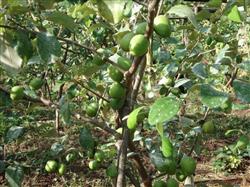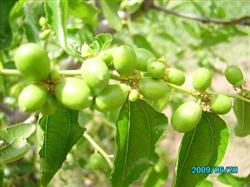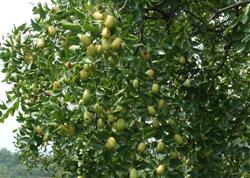How to grow green dates?

How to grow green dates? Please give guidance for planting green jujube can refer to the following materials: first, green jujube fruit tree growth and development characteristics green jujube shows the habit of continuous growth throughout the year, as long as the temperature is suitable, the terminal bud will grow forward, and then sprout side branches. Every 3 nodes of the branch, the rib-like alternate branching technique is also a subordinate branch every 3 nodes, and finally forms a trunk at the branch level. The primary branch (main branch), secondary branch and third-fourth branch (the main fruiting branch) can grow to 2 meters, with an average of 16 secondary branches. The second branch can be 12 meters long, with an average of 8 third-order branches: the third-order branch length is large 60CM, which can grow many fourth-grade branches. II. Characteristics of flowering and fruiting of green jujube flower bud differentiation in the current season (year), rapid differentiation, large number of flowers, same branch of flowers and fruits, flowers bloom during the day, bloom at 6-8 o'clock in the morning, bloom at 8-11:00, and rarely open after 12:00: pollination for insect-borne flowers, flies, bees and other insects, can blossom in 70 days in the first year, and can blossom and bear fruit many times a year. It takes about 120 days from flowering to fruit ripening, and blossoms continuously with the main length of the shoot from April to December, but the fruit setting ability of flowers in different periods is different. From April to June, the fruit setting rate of flowers is low, the fruit setting rate of July-August flowers is low, and the fruit setting rate of flowers from September to October is high, and a large number of fruits mature in January-February. From a tree point of view, the main result is that the third-level extension accounts for 90% of the total fruit, the second-level branch accounts for 9.5%, and the first-level branch (main branch) accounts for only 0.5%. Third, jujube soil for environmental conditions: jujube tree is not strict with soil, but it is more suitable for soil with micro-alkali (PH value 7.5) to acid PH value above 6.0.It requires sandy loam soil and it is convenient for drainage and irrigation in deep soil layer. Temperature: green jujube is a positive plant. Sufficient sunlight is needed, the average annual temperature in the planting area is more than 18 ℃ (Yuanjiang 23.8 ℃), and the extreme minimum temperature is not less than 0 ℃. The temperature difference between day and night during the fruit expansion period is large, which is helpful to sugar accumulation. It is suitable for planting below 1200 m above sea level. Moisture: green jujube has developed root system and strong drought resistance, and can grow normally in areas with annual rainfall 500mm (Yuanjiang 780mm) relative humidity greater than 50%. Jujube flowering requires higher humidity, relative humidity at 85% is conducive to pollination, fertilized fruit ripening period requires less rain and more sunny weather, otherwise it is easy to cause a large number of fallen flowers and rotten fruit. 4. Planting (1) digging ponds, fertilizing and backfilling: tree ponds are required to be 1 meter long and 1 meter wide. 0.5 meters deep; 4 Murray 6 × 5 Murray 7 meters dig a pond, one plant per pond, 1633 trees per mu. After the pond is dug, each pond will apply 30ml 40kg mature farm manure, 0.5-1kg calcium magnesium superphosphate or calcium magnesium phosphate fertilizer. Fertilizer should be applied in three layers, each layer of fertilizer should be backfilled with a layer of soil. When returning to the soil, all the soil dug out above should be returned to the hole, and the mound with 20cm height and diameter of 1 meter should be piled up. (2) in the selection and allocation of varieties, superior varieties must be selected for planting. Excellent varieties have four conditions: 1, large fruit, crisp meat, high sweetness, no astringency. Slightly sour taste: 2, thin peel with smooth and bright, yellowish green, good taste, no left after eating; skin feeling. 3, small seeds and thick flesh, high soluble solids: 4, strong resistance, especially resistance to diseases and insect pests. For example, Gaolang No. 1 has the above four conditions. Green jujube is a cross-pollinated plant. Pollination varieties must be configured, any two varieties can be pollinated with each other, usually 6-8:1. (3) the planting period can be planted in spring, summer and autumn except winter. Spring March-May. June-July in summer and September-October in autumn. The planting of Yuanjiang from March to April is more suitable for a better harvest in the same year. (4) planting operation 1. Plant the seedlings in the planting bag and the four seedlings with mud; put the seedlings into the planting hole, gently cut off the packing bag with a sharp knife, do not loosen the interphase mud mass as far as possible, and then hold the seedlings with one hand, so that the neck of the root is basically flush with the surface of the tree plate. with the other hand, use fine soil from the top to the root of the tree. 2. Planting bare root seedlings: dig the planting holes according to the length of the main and lateral roots, and let the main roots and lateral roots stretch naturally. First, the main root is fixed with crushed soil, and then the lateral root is buried one by one. Finally, the fine soil is filled into the gap between the main root and the lateral root. Let the fine soil fully contact with the root system. Layered compression should be gradually compacted from the outward trunk in real time, and the most important thing is to be compacted next to the main root at the beginning, or to overstep on it with your feet. causing the rhizosphere to be airtight. When filling to the root neck, pour enough water to fix the root, then fill the crushed soil above the root neck to 2mur3 cm, the tree plate is about 1 meter in diameter, and then cover the tree plate with dried (rice) grass to moisturize, cool, prevent topsoil hardening and inhibit the growth of weeds. Note: the seedlings should be truncated at the height of 30--40cm before or after planting. Bagged seedlings generally need to remove the leaves of 2par 3, while bare root seedlings cut off all the leaves and leave only the petiole. you can also put a plastic film on the stem to reduce water evaporation. (5) if it does not rain after planting, it should be watered every 3 days until the new leaves germinate and turn green. Do not rush to apply fertilizer from planting to the first shoot extraction. In particular, do not apply high concentration of chemical fertilizer and manure. When the first new shoot turns green and mature and begins to extract the second new stall, apply 0.5% of compound fertilizer and water outside the trunk 20cm. Or after the rain from the trunk 20-30cm application of compound fertilizer 20MUE 30g once every 10 days, a total of 2Mel 3 times. 5. Main cultivation and management techniques (1) fertilization techniques 1. Fertilization for new planting trees: new jujube trees need fertilizer supply and are easy to hurt their roots because of their underdeveloped roots. therefore, fertilization should adhere to the principle of frequent application of thin fertilizer, that is, the principle of eating less and eating more meals should be applied twice. Can be irrigated rotten manure, chemical fertilizer, or fertilizer in the rain in the application, farm fertilizer and chemical fertilizer alternately. ① base fertilizer; after the pond was dug, 40 kg of rotten farm manure and 0.5 kg of phosphate fertilizer were applied. ② topdressing: 15%-20% clear urine water is usually used for topdressing farm manure (about 25 kg per bucket plus 3.5 Mel 5 dry grams of 3 spoons of raw human and animal urine); M is used 7 Mel 13% mature human and animal dung water. The above two kinds of plants should be irrigated with 3.5kg-5kg per plant each time, which should be applied outside the trunk 20cm and gradually moved out with the expansion of the crown. Topdressing chemical fertilizer, each plant can be applied urea or compound fertilizer 25Mel 50g each time; it can be applied to the water (the concentration is 0.4 Mel 0.5%), or it can be evenly spread in the dripping line of the tree plate (if it is not necessary to open the ditch after rain). 2. ① base fertilizer was applied to perennial trees. After retraction and pruning from February to March, each plant was deeply ditched at the dripping line of the crown and was deeply applied with livestock manure 20ml, 30kg phosphate fertilizer 0.5-dry gram. At this time, root cutting by fertilization can adjust the balance of root-shoot ratio and promote shoot growth. ② strong shoot fertilizer, mainly nitrogen fertilizer, N:P:K=2:1:1, began to sprout new shoots from April to August after a month of retraction. Therefore, from April to June, each tree should apply 15% compound fertilizer 1.5 kg plus 46% urea 0.5 kg as strong shoot fertilizer, preferably in three stages. ③ fertilizer for promoting flowering: flowering and hanging fruit from September to October, so it is required that the fertilizer for promoting flowering should be mainly available fertilizer from July to August, and the suitable combination of nitrogen, phosphorus and potassium (2:1:2). Each plant was applied 0.5 kg compound fertilizer, 0.2 kg urea, 0.2 kg potassium chloride (or potassium fluidic acid), 0.1 kg magnesium sulfate and 50 g borax. ④ strong fruit fertilizer; from January to December, N:P:X=2:1:4 was applied with compound fertilizer 1kg urea 0.25kg, potash fertilizer 03kg magnesium sulfate 0. 5kg per 5 plants. Ganke. 50 grams of zinc sulfate. Applied in three times. In this period, 0.2% borax and 0.2% potassium dihydrogen phosphate can also be used for foliar spray topdressing. (2) Water management 1. During the shoot growth period (4.7 months), the tree crown should be cultivated and irrigated in time in case of drought, otherwise the tree strength is not strong. 2. Irrigation should be suspended during the flowering and fruit setting period (9.10 months) to promote the plant from vegetative growth to reproductive growth. 3. The plant needs a lot of water during the fruit development period (lllz month). If the mule is wet at this stage, it is easy to lead to flat fruit drop. 4. Avoid a large amount of irrigation during the harvest period (December). Otherwise, the quality will decline. (3) Crown management 1. Shaping and pruning, the growth of jujube trees is large, and the branches are soft, slender, fragile and vulnerable to wind damage. ① newly planted trees are pruned; cut short and dry at 30-40Cffi height after planting. The well is supported by bamboo sticks to keep the seedlings upright. After germination, four side branches with strong and good growth position were selected as the main branches (primary branches) and led to the square with bamboo poles (lines). Make it evenly distributed to form a happy tree. Then the rib-like lateral branches (secondary branches) are formed alternately on the main branch. the new shoot of lateral technique is the fruiting branch of the current year (third or fourth grade branch). Pruning usually begins in June and ends in November after all fruits are set. Cut off 7 kinds of branches, namely, cross branches, over-dense branches and overgrown branches. straight branches, slender branches, disease and insect branches, mop branches. In November, the young fruit or spike at the end of the tip can be cut off if the fruit is already quite large. The tree has been pruned for more than ② years. The main branch needs to be retracted and renewed after fruit harvest (February-March). There are three ways. The first is the renewal method of truncating the main branch: the main branch is sawed off at 20ml / 30cm above the original graft interface, leaving a proper place for the new shoot to grow, and the four branches with strong growth are cultivated into the main branch. 2 reserved stent renewal method: cut the main branch 1.5 meters short, and cut off all the side branches on the main branch, and then cut around at the base of the main branch about 30 cm (peeling the mouth 5ml 10 cm, the narrow is easy to heal) choose a strong bud near the trunk and tie the new technique to the original main branch to cultivate the new main branch of the year. The third is the method of grafting and replacement. Green jujube is prone to budding and natural hybrid varieties emerge one after another. After fruit picking, the scions of superior varieties are grafted on each branch by walking or cutting method at a height of 30m / 60cm from the ground. 2. The frame ① can be built into triangles and quadrilaterals according to the tree shape. ② cement column frame. (3) the fruit sparse green jujube has a large number of flowers and fruits, with 8-30 florets per inflorescence. Generally, it can bear 4-5 fruits, although it is still excessive after natural fruit drop, it needs to be removed manually to avoid wasting nutrients. Fruits and vegetables are carried out before and after the size of fruits such as peanuts. First of all, combined with pruning, cut off the slender branches, long branches and over-dense branches of your own fruit, and then remove the over-dense fruit, fine fruit, yellow diseased fruit and abnormal fruit. Generally 1-2 inflorescences leave one fruit (that is, "1 node 1 fruit" or "2 node 1 fruit"). (4) pest control techniques: there are mainly beetles, red spiders, yellow thorn moths, heart-eating insects and so on. ① beetles. In order to damage the leaves, 40% poisonous herbs can be used for 11000 times control, and it is best to kill them manually. ② red spider; causes defoliation in order to damage the leaves (back). Harms the fruit, causing rough brown scars on the fruit surface. Affects the appearance and endoplasm. It can be controlled with 20% triclofenac EC 800ml 1000 times or 73% propargite EC 20003000 times. ③ yellow diamondback moth. You can control it with poison silk 1, 000 times or Regent 1, 000 times or enemy kill (or kung fu) 1, 000 times. ④ heart borer. Heart borer drills into the fruit to feed on the pulp and accumulates insect dung in the fruit. The fruit becomes rotten, smells and loses its edible value. Prevention and control should seize two periods: first, ground closure should be carried out before adult Eclosion is unearthed, and the soil under the crown can be closed with 1000 times of 50% phoxim or 40% poisonous silk, so as to poison the adults unearthed by Eclosion, and after spraying phoxim, the soil should be turned over shallowly to avoid drug photolysis. Second, the crown can be sprayed with 2000-3000 times of trimethoprim or 2.5% of Laifuling 2000-3000 times during the occurrence of adults or the peak period of oviposition. 2. Diseases: mainly powdery mildew, which harms young leaves and young fruits (fruit), resulting in numbness, wrinkle, no luster and cork. It can be treated with 50% sulfur gel suspension 200400 times, 15% trimethoprim 1Ru 800-1000 times, 40% Shenxing EC 1RV 5000-8000 times, and 62.25% Xiansheng Wet Powder 1RU 600 times. Click to get more jujube planting techniques click to get more fruit planting techniques
- Prev

How to improve the fruit setting rate of winter jujube?
How to improve the fruit setting rate of winter jujube? Please guide the method of winter jujube fruit setting rate can be improved by the following methods: First, summer shear winter jujube trees entering the fruiting period, in order to set fruit normally, in addition to doing winter shear, but also must do summer shear. Summer pruning begins with germination, and the heads of dates that do not need to be cultivated are removed. May...
- Next

How to manage winter jujube trees in July?
How to manage winter jujube trees in July? Please guide the winter jujube tree management in July can refer to the following methods: 1. Fertilization. For adult jujube trees with fresh jujube yield of about 15 kg, fertilize according to the standard of urea 1.1 kg, phosphorus pentoxide 0.25 kg, potassium sulfate 1.8 kg.
Related
- Moge, come on! The staff of the peasant association in the producing area of cantaloupe were frightened when the crowd gathered.
- Causes and Solutions of low Fruit setting rate of Apple
- Symptoms and control measures of passion fruit virus disease
- Fruit growing lesson: how do apple orchards keep high yields?
- Can you build orchards in the mountains? What are the pros and cons?
- How to manage the coloring period of Crisson grape?
- This paper introduces the processing technology of two kinds of fig products.
- How much is a month for retired teachers in rural areas by 2020?
- How can strawberry planting increase sugar content? We should pay attention to management in many aspects.
- What are the cultivation techniques on how to improve the yield of golden fruit?

